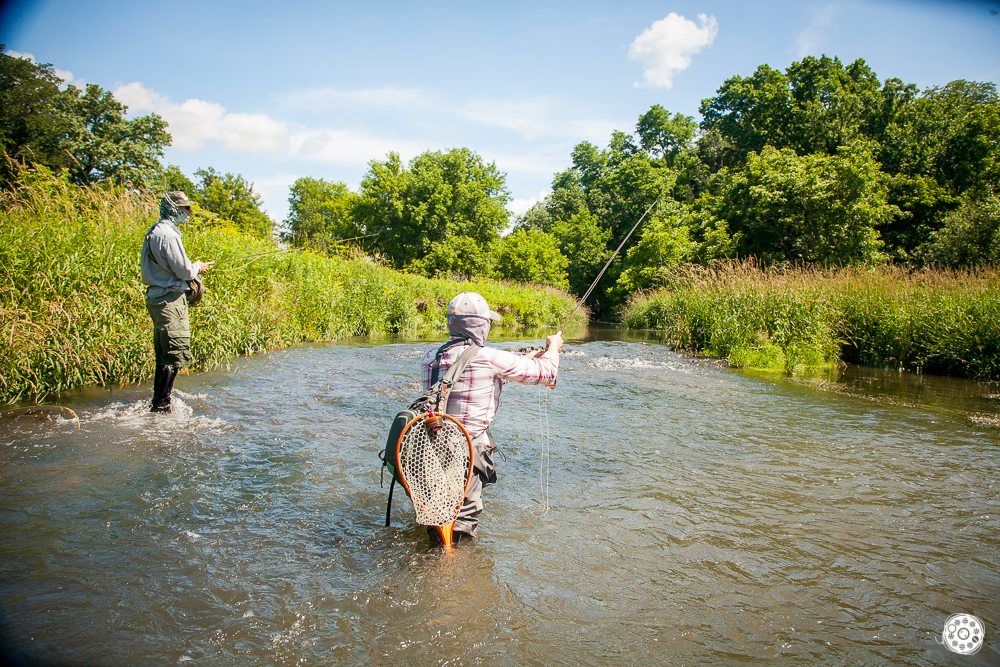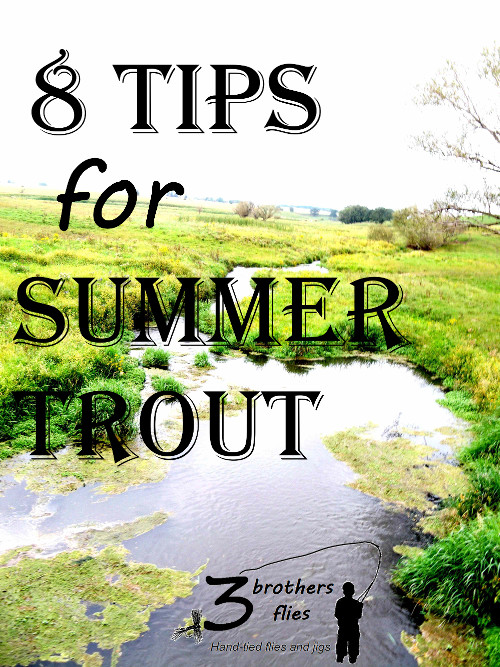3 tips on how to fly fish the Trico spinner fall with less frustration, more trout, and more triumph
There are hardly any hatches that bring as much frustration and triumph as the Trico hatch of summer and early fall. Massive spinner falls of these minuscule mayflies, sometimes stretching down to a #26, bring trout to the surface like lumberjacks eating pancakes. It can be an agonizing hatch, filled with long leaders, uncivilly early mornings, tiny bugs, perversely difficult trout, fine tippet, and often a good dose of tears. But there’s not much in fly fishing that’s as rewarding as fooling a good trout on a Trico dry fly.
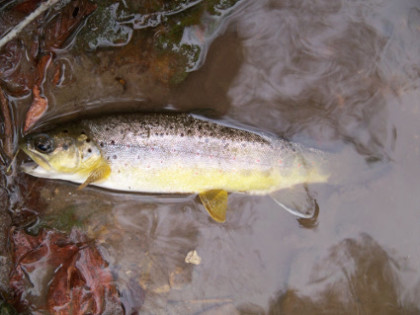
Tricos start to hit streams in mid July and provide consistent and reliable match-the-hatch dry fly fishing until late September. Male duns (hatched mayfly adults) emerge in the evening, followed by female duns in the early morning, but it’s the spinner fall that attracts the most attention, and for good reason. Trout stack up and feast on these tiny dead mayflies, which congregate above the water in sprawling mating clouds that sometimes darken the air like a thick fog on a cold fall morning. It’s an awfully sweet sight for a fly fisherman, yet it also brings plenty of challenges. Spinners tend to appear when the air temp hits 68 degrees F, an affair that usually happens at a horribly uncivil hour of the morning in the hot summer months. But even with the severe shortage of sleep, you’ll have to hold back on the caffeine as jittery hands have a hard time tying on the #20-24 dries that Tricos demand. Trout sipping Tricos also have nasty habit of sitting in calm slicks and glassy runs, affording them plenty of time to scrutinize an artificial fly and its presentation. Long leaders and finely executed drifts are a must, though you’ll certainly get a few refusals even with what looks like a perfect presentation.
Tricos are a game of challenges and stealth and strategy. But that’s partly what makes them so rewarding. There’s nothing quite like the triumph of devising a strategy, making a perfect drift, and catching a trout on a tiny dry fly.
The Trico spinner fall is my favorite mayfly event of the trout season here in Minnesota, though it’s certainly not because I catch lots of fish. The tiny bugs have beat me more than a few times, and I haven’t come close to cracking the code (if it is indeed possible), but I have learned a few things over the past seasons and usually manage to catch a few trout each time I hit a good spinner fall. Here are a few tricks and tactics I’ve learned over the past few seasons that have lessened the frustration and increased the triumph over the Trico spinner fall…
#1. Double Dry Fly Rigs
Double dry fly rigs are mainstays in any good Trico strategy. Tracking tiny Trico dries, both for detecting takes and keeping a tidy drag-free drift, is a large part of successfully fishing the Trico spinner fall. Drag a fly over rising trout and you’re sure to get a refusal. Rip the leader across the pool on a misjudged strike and you’ll send any nearby risers straight into the undercuts. A buoyant, visible dry fly tied twelve inches up the leader lets you track and manage your drift, something that, unless you have eyesight better than a blue heron, is quite difficult to pull off with minuscule, low-riding Trico spinner patterns. Sometimes trout will even take the bigger dry.
Small hi-vis beetles, Ausable Bombers, Stimulators, and any other bugs that float like corks and stand out like ducklings are viable options. There is, however, a very real danger of tossing a fly that’s too gaudy and spooking wary trout. Foam hoppers or anything else that splats on the water makes a poor lead fly, while flies with lots of hackle and a soft landing are better options. Leader twist is also a potential problem, as big, air resistant bugs don’t tend to cast well on the long, fine leaders necessary for Trico-sipping trout. For these reasons, I like to fish dries in the #12 to #16 range, preferably something on the smaller end. Lately I’ve been fishing a #14 Pass Lake, an old Wisconsin pattern with a distinctive white, trude-style calftail wing and a pheasant tippet tail that vaguely resembles a Trico and draws a few strikes itself. Tie it to 5x tippet on a leader that’s as long as you can handle, and drop a Trico spinner twelve to sixteen inches off the bend on 6 or 7X, using clinch knots for all three connections. Micro-drag between the two dries can also be a concern, so make sure the trailing tippet is long enough to allow a good dead drift (single dries are nearly always the most fool proof way to obtain a better drift and avoid this, though double dry rigs have their share of advantages).
Whatever bug you decide to tie on, a double dry fly rig can be a very valuable asset in your Trico strategy.
#2: Sunken Trico Spinner
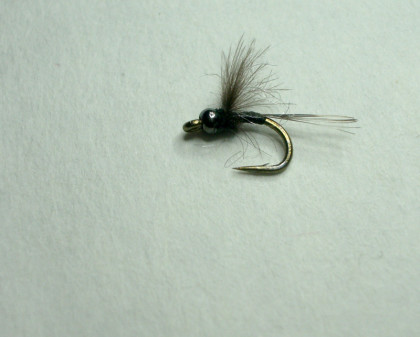
One of my absolute favorite tactics for fishing spinner falls is dropping a Sunken Trico Spinner off the bend of a dry fly or nymph. It’s an especially deadly strategy for pressured creeks where trout see dozens of sloppy presentations and artificial flies. Sunken spinners are nothing new to the Trico scene and have proven themselves on many tough trout streams. Like any hatch, fish get wise to the whole (dry) fly fishing game, but sunken spinners will often fool fish that are hesitant to take a fly on the surface.
Along with taking cautious fish, sunken spinners will still provide good action long after trout have stopped rising to the morning spinner fall. This is one of my personal favorite tactics for late summer and early fall. Tricos are one of the most prolific and dependable hatches on Driftless streams (and many other regions), popping of quite regularly during the summer and fall months, and trout become accustomed to seeing sizable numbers of these bugs on a daily basis. Plenty of them get churned underwater and drift through the system long after the duns and spinners have quit their aerial activity. On any given moment in early September, you’re likely to find at least a few drowned spinners flowing through a trout stream, particularly in the lower stretches. And trout don’t ignore them.
Sunken spinners are nearly always on my nymphing rig during Trico season. I like to hang them 14“ behind an attractor nymph, usually something like a Trout Snatcher or Squirrel and Copper. Fish them as you would any prospecting nymph rig, casting to any likely riffles and pools. Back eddies and foam lines are particularly productive spots as they collect tons of bugs – and feeding trout. And while they’re certainly quite effective right after the trout stop rising, don’t forget to toss them during later hours.
#3: Double Trico Spinner
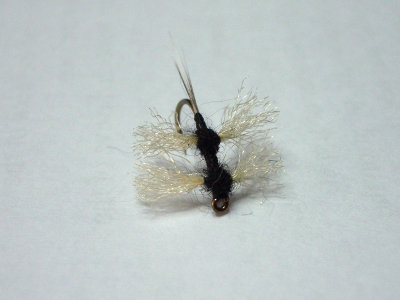
If you’re anything like me and occasionally have trouble hooking trout on #22 dries, a Double Trico Spinner is a good change of pace from the tiny bugs. Tied on a #16 dry fly hook, the Double Trico sports two full sets of Trico bodies and wings, offering a bit of extra room for hooking fish. It has saved plenty of frustration on days when the tiny dries prove to be too difficult. And while it’s not the most imitative Trico pattern and won’t perform as well on especially persnickety fish or during sparse spinner falls, most of the time the trout don’t seem to mind the extra body on the hook, making it a great pattern for days when the fish just aren’t sticking.
Glassy, calm flats and runs aren’t ideal spots for the Double Trico due to the extra inspection time they afford the trout. Instead, focus on faster water and foam lines and swirling eddies, where the trout are far more eager to sip an artificial. Trico fish have a habit of sitting in perversely difficult or calm spots, but there always seem to be a few that hold in more fishable areas. These are the ones I’m usually after.
Trailing a standard Trico Spinner 16“ behind it is also a good strategy. The smaller dry gives the fish a more precise option, and if they take the Double Trico you’ll have a much easier time hooking them.
————o————
Despite the many challenges and frustrations, Tricos are one of the most fun and rewarding hatches of the season. There have been many mornings filled with frustration, and occasionally triumph, but all the time I’ve spent standing in a cold, meandering stream, watching the morning fog lift from the water, and tossing tiny dries to hungry trout has been very memorable and rewarding. Next time you find yourself on a trout stream in the dawn hours of a summer morning, remember a few of these tips. Some challenge and frustration is inevitable, and perhaps imperative to a rewarding experience, but hopefully these tactics, flies, and tips will increase the prospects of triumph over the Trico hatch.
Tight lines and good luck on the water!
Conner
————–o————–
(All the Trico patterns mentioned are available over on the Fishing Gear shop. Also, check out the fly box page for tying recipes. Tight lines and thanks for the support!)

